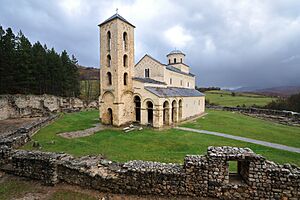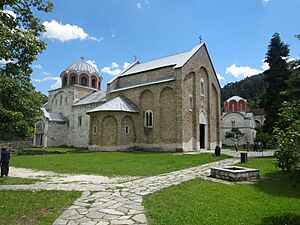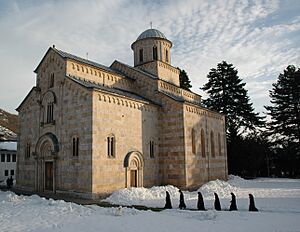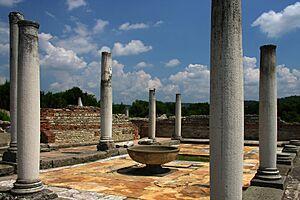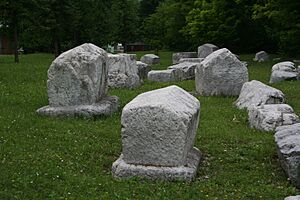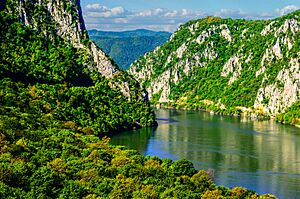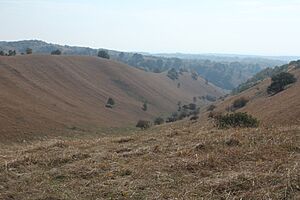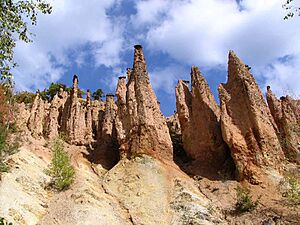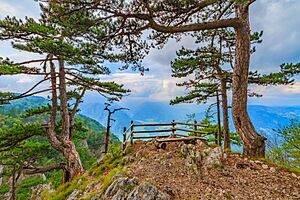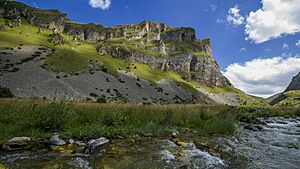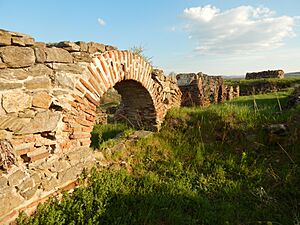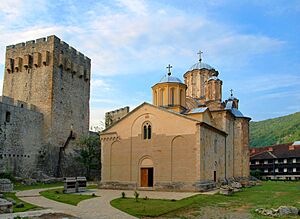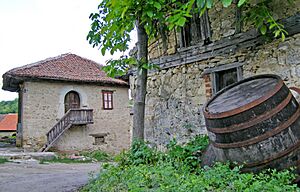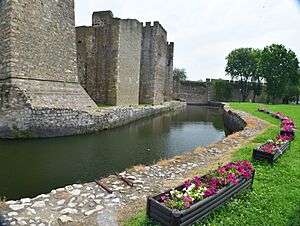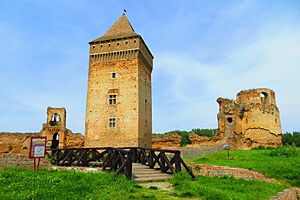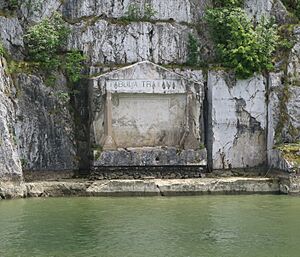List of World Heritage Sites in Serbia facts for kids
The United Nations Educational, Scientific and Cultural Organization (UNESCO) is a special group that helps protect important places around the world. These places are called World Heritage Sites. They are chosen because they have amazing cultural heritage (like old buildings or art) or natural heritage (like unique landscapes or wildlife).
Countries that agree to UNESCO's rules can suggest places to become World Heritage Sites. Serbia joined this agreement in 2001, after the country of Yugoslavia broke up.
As of 2021, Serbia has five sites on the official World Heritage List. It also has eleven more places on a "tentative list," which means they might be added later. The first site from Serbia to be listed was Stari Ras and Sopoćani in 1979. All of Serbia's listed sites are cultural, meaning they are important for human history or art. Most of them are from the medieval period (the Middle Ages), except for the Gamzigrad complex, which is from a bit later, in late antiquity.
One site, the Medieval Monuments in Kosovo, has been on UNESCO's list of endangered sites since 2006. This is because it's hard to manage and protect these old monuments due to political issues in the region. Another site, the Stećci Medieval Tombstones Graveyards, is shared with three other countries.
Serbia's Amazing World Heritage Sites
UNESCO uses ten different rules to decide if a place can be a World Heritage Site. Each site must meet at least one of these rules. Rules one to six are for cultural sites, and rules seven to ten are for natural sites.
* Transnational site ![]() In danger
In danger
| Site | Image | Location | Year Listed | UNESCO data | What Makes It Special |
|---|---|---|---|---|---|
| Stari Ras and Sopoćani | Novi Pazar | 1979 | 96; i, iii (cultural) | Stari Ras was Serbia's first capital city. It has many important medieval buildings like old forts, churches, and monasteries. The Sopoćani monastery shows how Western and Byzantine cultures connected long ago. | |
| Studenica Monastery | Kraljevo | 1986 | 389; i, ii, iv, vi (cultural) | The Studenica Monastery was built in the late 1100s by Stefan Nemanja, who started the medieval Serb state. It's the biggest and richest Orthodox monastery in Serbia. Its two main churches have amazing paintings from the 1200s and 1300s. | |
| Medieval Monuments in Kosovo |
Dečani, Gračanica, Peć, Prizren | 2004 | 724; ii, iii, iv (cultural) | This site includes four important monuments: Gračanica Monastery, Our Lady of Ljeviš Church, Patriarchate of Peć Monastery, and Visoki Dečani Monastery. These buildings show the best of Byzantine-Romanesque art and architecture from the 1200s to the 1600s in the Balkans. Their unique wall paintings greatly influenced later art in the region. This site was put on the "in danger" list in 2006 because of challenges in protecting it due to political instability. | |
| Gamzigrad-Romuliana, Palace of Galerius | Zaječar | 2007 | 1253; iii, iv (cultural) | This ancient Roman palace and memorial complex was built by Emperor Caius Valerius Galerius Maximianus around 300 AD. It was called Felix Romuliana, named after his mother. The site has strong walls, a palace, temples, baths, and other important structures. It's special because it combines ceremonial and memorial uses. | |
| Stećci Medieval Tombstones Graveyards* | Perućac, Rastište, Hrta | 2016 | 1504; iii, vi (cultural) | Stećci are medieval stone tombstones found in parts of Bosnia and Herzegovina, Croatia, Serbia, and Montenegro. They first appeared in the 1100s and were most popular in the 1300s and 1400s. Serbia has three sites with these tombstones: Perućac, Rastište, and Hrta. |
Places Serbia Hopes to Add (Tentative List)
Besides the sites already on the World Heritage list, countries can keep a list of places they might want to nominate in the future. A site must be on this "tentative list" before it can be officially nominated. As of 2021, Serbia has eleven sites on its tentative list.
| Site | Image | Location | Year Listed | UNESCO Criteria | What Makes It Special |
|---|---|---|---|---|---|
| Đerdap National Park | Bor District | 2002 | vii, x (natural) | This national park includes the Đerdap (Iron Gates) canyon of the Danube river. It has amazing landforms like gorges and limestone areas. Many different animals and plants live here. The important ancient site of Lepenski Vir is also in this area. | |
| The Deliblato Sands Special Natural Reserve | Banat | 2002 | viii, ix, x (natural) | This is a huge sandy area, left over from an ancient desert when the Pannonian Sea dried up. Most of the area is now covered with plants that were carefully planted over the last 170 years. | |
| The Đavolja Varoš ("Devil's Town") Natural Landmark | Kuršumlija | 2002 | vii (natural) | These are unique rock formations created by water wearing away volcanic rock. There are over 200 rock pillars, from 2 to 15 meters tall. Most have a cap of harder rock on top, which protects them from further erosion. | |
| The Tara National Park with the Drina River Canyon | Zlatibor District | 2002 | x (natural) | This is an important area for protecting nature, with many different kinds of plants and animals. Some endangered animals here include the brown bear, chamois, and golden eagle. | |
| Šar Mountains National Park | South-west Serbia (Kosovo and Metohija) | 2002 | vii, x (natural) | This national park is one of the most important protected areas in the Balkans. It has over 1,500 types of plants, with about 20% of them found nowhere else. Many bird species also live here. The high parts of the mountains have features of both Alpine and Mediterranean regions. | |
| Caričin Grad – Iustiniana Prima, archaeological site | Jablanica District | 2010 | ii, iii (cultural) | This ancient town was built by the Byzantine Emperor Justinian I near where he was born. He built it to help the Byzantine Empire control the area and spread Christianity. | |
| Fortified Manasija Monastery | Despotovac | 2010 | i, ii, iv, vi (cultural) | This monastery was built after the Battle of Kosovo by Despot Stefan Lazarević. It was built between 1406 and 1418. Its special feature is its strong fortifications, which could defend and protect the monastery and its people. | |
| Negotinske Pivnice | Negotin | 2010 | iii, iv, v, vi (cultural) | These are old wine cellars in the Negotin area, built from the mid-1800s onwards. They were often built to be bigger and better than the family homes! People here still follow many old traditions related to making wine. | |
| Smederevo Fortress | Smederevo | 2010 | iv, v (cultural) | This fortress is the last great military building made by Serbs and one of the largest forts in Southeast Europe. It was built to replace Belgrade as the capital after Belgrade was given to the Hungarians in 1427. Its design was influenced by the famous Walls of Constantinople. | |
| Cultural landscape of Bač and its surroundings | Bač | 2019 | ii, iii, v (cultural) | The town of Bač has buildings from the 1100s to the 1800s, showing influences from Romanesque, Gothic, Renaissance, Byzantine, Islamic, and Baroque art. Many different ethnic groups live here, including Serbs, Slovaks, Croats, Hungarians, Romanians, and Roma. They mostly work in farming and raising animals. | |
| Frontiers of the Roman Empire – The Danube Limes (Serbia)* | several sites | 2020 | ii, iii, iv (cultural) | These are old Roman forts and border defenses along the limes (border). Sites in Serbia include remains at Petrovaradin, Belgrade, Zemun, Kladovo, Golubac, and Tabula Traiana. This nomination is shared with Croatia, Bulgaria, and Romania. |
See also
 In Spanish: Anexo:Patrimonio de la Humanidad en Serbia para niños
In Spanish: Anexo:Patrimonio de la Humanidad en Serbia para niños
- Cultural Heritage of Serbia
- Immovable Cultural Heritage of Great Importance (Serbia)
- List of protected natural resources in Serbia
- List of fortifications in Serbia


